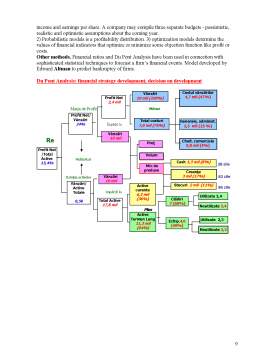Extras din curs
1.1. The Role, Objectives and Goals of Financial Management
The objectives of the Financial Management:
- The maximization of the enterprise’s economic value (equity): profit-investment; profit-risk
- Maximizing shareholder wealth as the primary goal.
- Shareholder wealth is defined as the present value of the expected future returns to the owners of the firm. It is measured by the market value of the shareholders’ common stock holdings.
- Explanation using the Balance Sheet structure (LTA, CA; E, STD, LTD)
The goal of shareholders wealth maximization specifies how financial decisions should be made. In practice not all management decisions are consistent with this objective. Some companies (Bennett Stewart, Coca-Cola, US) have developed an index of managerial performance that measures the success of managers in achieving a goal of shareholders wealth maximization. Measure called Economic Value Added is a difference between a firm’s annual after/tax operating profit and its total annual cost of capital. Other firm, such as Panhandle Eastern, Disney and Ford Motor Company, expect top managers and directors to have a significant ownership stake in the firm. Panhandle Easter’s president is paid entirely in the company’s common shares (25,000 per quarter) and medical benefits.
- The increase in the competitive power
- Enterprise’s stability through risk minimization
- The enterprise’s image
- Social objectives, the environment
How the managers should achieve the goal of maximization shareholders wealth? One might argue that managers will maximize shareholders wealth if they maximize the profits of the firm. Unfortunately, the profit maximization has too many shortcomings. Some of the limitations of profit maximizations are: necessity to extend the output, increasing the financial risk (due to the fact that increasing the earning per share is correlated with increasing the proportion of debt financing used in the firm’s capital structure).
If the profit maximization objective does not provide the proper guidance to managers seeking to maximize shareholders wealth, what rules should these managers follow? Managers should attempt to maximize the market value of the company’s shares, not the book value per share. The book value reflects the historical cost of assets, not earning capacity of those assets. Market share is defined as the price at which the stock trades in the marketplace, such as New York Stock Exchange.
Three major three factors determine the market value of a company’s shares of stock:
- The amount of the cash flows expected to be generated for the benefit of shareholders (Only cash can be used to acquire the assets, not depreciation)
- The timing of this cash flows ($100 today are different from $100 three ears from today)
- The risk of the cash flows (0the greater the risk associated with an expected cash flow, the greater is the rate of return required by investors).
1.2. The Functions of Financial Management
The finance function is usually headed by a vice-president of finance or chief financial officer (CFO), who reports to the president. The CFO often distributes the financial management responsibilities between the controller and treasurer. The functions are showed in the fig.1.
Fig. 1. Sample organization chart of financial function in an organization
The treasurer normally is concerned with the acquisition, custody and expenditures of funds
- To assure the necessity of the financial funds
- To assure profitability; financial equilibrium, to remove risks
- Financial forecasting
The controller normally has responsibility for all accounting-related activities.
- Financial control
Financial Managers’ Functions:
- The efficient allocation of financial funds according to domains of activity
– assets’ administration
– allocation of resources aimed at increasing capital
- The best mobilization of resources
– sources of funds’ formation (short-term, long-term ones)
– the utilization of financial levers, the determination of barriers
– the optimization of the capital structure
– net profit
– the source of own resources formation.
Preview document
Conținut arhivă zip
- The Concept of Financial Management.doc































